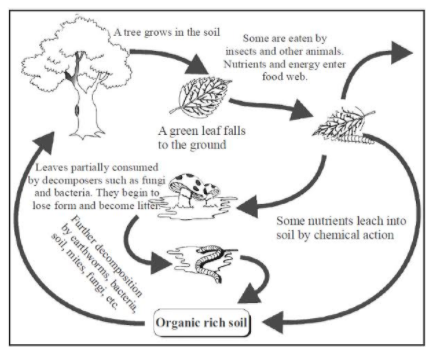
What is decomposition? Write down its steps. Give its diagrammatic representation of decomposition cycle in the terrestrial ecosystem.
Answer
494.1k+ views
Hint: Decomposition is the procedure in which dead organic material is broken down into organic or inorganic matter such as carbon dioxide, water, simple sugars and mineral salts. Insects such as earthworm and termites help in the process of decomposition.
Complete answer:
The term Decomposition is used for the process in which organic composite substances are broken down into soft inorganic tissues substances like CO2, water and nutrients by decomposers such as termites or earthworms. The main location of decomposition is the upper layer of soil in terrestrial habitat as well as the bottom surface of water bodies.
It involves the following steps:-
FRAGMENTATION: is the process of breaking down of detritus into smaller particles. It is done by earthworms as well as termites. Due to the fragmentation process, detritus is changed into fine particles which have a large surface area.
LEACHING: is the process by which water-soluble in-organic nutrients such as - sugars, go deep down into the soil horizon and get precipitated as unavailable salts are called leaching.
CATABOLISM: is an enzymatic process by which degraded detritus is further converted into simpler in-organic substances is called catabolism. The process is carried out by saprotrophic bacteria along with fungi.
HUMIFICATION: is the process of accumulation of a dark-colored amorphous substance known as humus that undergoes decomposition at the slow moving rate is called humification.
MINERALISATION: is the process by which humus is further degraded by some microbes to release in-organic nutrients is called mineralization.

Note: A decomposition reaction is a type of chemical reaction in which a single element breaks down into two or more new elements. These decomposition reactions often involve an energy source such as heat, light, or electricity that breaks apart the bonds of elements.
Complete answer:
The term Decomposition is used for the process in which organic composite substances are broken down into soft inorganic tissues substances like CO2, water and nutrients by decomposers such as termites or earthworms. The main location of decomposition is the upper layer of soil in terrestrial habitat as well as the bottom surface of water bodies.
It involves the following steps:-
FRAGMENTATION: is the process of breaking down of detritus into smaller particles. It is done by earthworms as well as termites. Due to the fragmentation process, detritus is changed into fine particles which have a large surface area.
LEACHING: is the process by which water-soluble in-organic nutrients such as - sugars, go deep down into the soil horizon and get precipitated as unavailable salts are called leaching.
CATABOLISM: is an enzymatic process by which degraded detritus is further converted into simpler in-organic substances is called catabolism. The process is carried out by saprotrophic bacteria along with fungi.
HUMIFICATION: is the process of accumulation of a dark-colored amorphous substance known as humus that undergoes decomposition at the slow moving rate is called humification.
MINERALISATION: is the process by which humus is further degraded by some microbes to release in-organic nutrients is called mineralization.

Note: A decomposition reaction is a type of chemical reaction in which a single element breaks down into two or more new elements. These decomposition reactions often involve an energy source such as heat, light, or electricity that breaks apart the bonds of elements.
Recently Updated Pages
Master Class 12 Economics: Engaging Questions & Answers for Success

Master Class 12 Maths: Engaging Questions & Answers for Success

Master Class 12 Biology: Engaging Questions & Answers for Success

Master Class 12 Physics: Engaging Questions & Answers for Success

Master Class 12 Business Studies: Engaging Questions & Answers for Success

Master Class 12 English: Engaging Questions & Answers for Success

Trending doubts
Draw a labelled sketch of the human eye class 12 physics CBSE

The final image formed by a compound microscope is class 12 physics CBSE

Differentiate between homogeneous and heterogeneous class 12 chemistry CBSE

What are the major means of transport Explain each class 12 social science CBSE

Which of the following properties of a proton can change class 12 physics CBSE

What is the energy band gap of silicon and germanium class 12 physics CBSE




